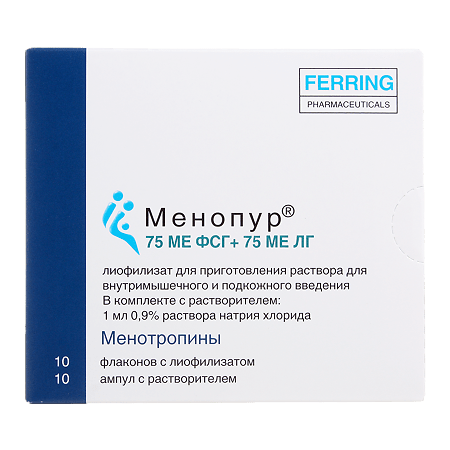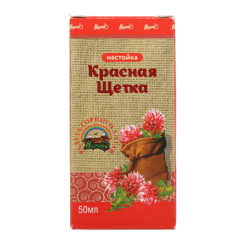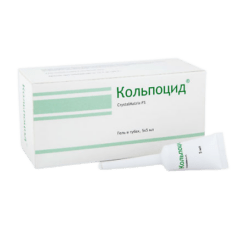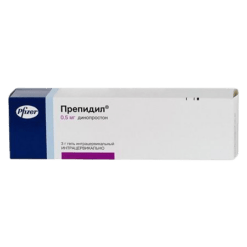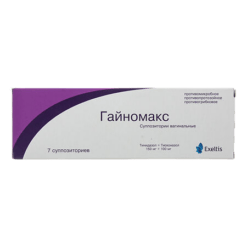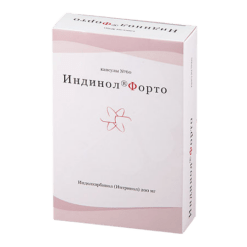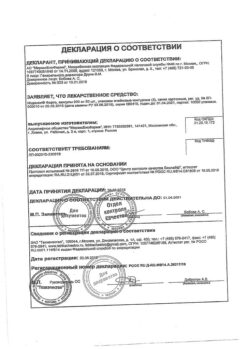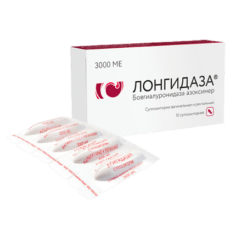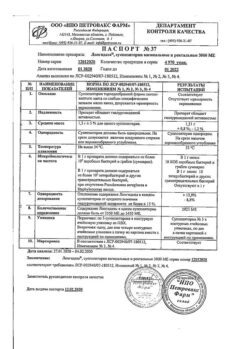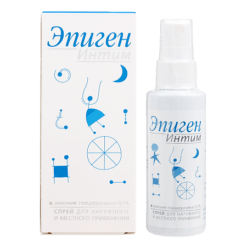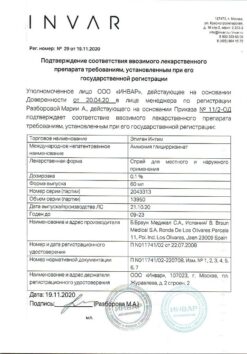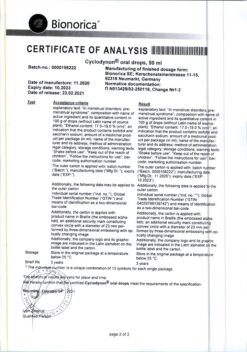No products in the cart.
Menopur, lyophilizate 75 me fsg+75 me lg 10 pcs
€1.00
Out of stock
(E-mail when Stock is available)
EAN: 7640128547655
SKU: 207722
Categories: Gynecology and Obstetrics, Infertility treatment IVF, Medicine
Description
Menopur is a gonadotropic.
Pharmacodynamics
Menopur® is a highly purified human menopausal gonadotropin (hGH) preparation. The product belongs to the group of menotropins and contains FSH and LH in a 1:1 ratio obtained by extraction from the urine of postmenopausal women. Menopur ® stimulates growth and maturation of ovarian follicles, increases estrogen levels and stimulates endometrial proliferation. Menopur® treatment is usually combined with human hCG (hCG) to induce final follicle maturation and ovulation.
Pharmacokinetics
Intake. Cmax FSH in plasma is reached within 7 h after p/u or i/m administration.
Distribution. Vd after repeated doses of 150 ME for 7 days is 8.9±3.5 IU/L when administered p/q and 8.5±3.2 IU/L when administered v/m.
Metabolism. Not studied.
Exhaustion. FSH concentration in blood decreases gradually. T1/2 is (30±11) h when administered by injection and (27±9) h when administered by injection. It is excreted mainly by the kidneys.
Indications
Indications
For women:
anovulation in polycystic ovary syndrome (if clomiphene therapy is ineffective);
controlled ovarian hyperstimulation to induce the growth of multiple follicles during assisted reproductive technologies (ART).
For men:
stimulation of spermatogenesis in azoospermia or oligoasthenospermia caused by primary or secondary hypogonadotropic hypogonadism (in combination with hCG drugs).
Pharmacological effect
Pharmacological effect
Menopur is gonadotropic.
Pharmacodynamics
Menopur® is a highly purified human menopausal gonadotropin (HMG) preparation. The drug belongs to the group of menotropins, contains FSH and LH in a 1:1 ratio. obtained by extraction from the urine of postmenopausal women. Menopur® stimulates the growth and maturation of ovarian follicles, increases estrogen levels, and stimulates endometrial proliferation. Treatment with Menopur® is usually combined with the administration of human hCG (hCG) to induce final follicular maturation and the onset of ovulation.
Pharmacokinetics
Suction. Cmax of FSH in plasma is achieved within 7 hours after subcutaneous or intramuscular administration.
Distribution. Vd after repeated doses of 150 IU for 7 days is 8.9±3.5 IU/l with subcutaneous administration and 8.5±3.2 IU/l with intramuscular administration.
Metabolism. Not studied.
Excretion. The concentration of FSH in the blood decreases gradually. T1/2 is (30±11) hours with subcutaneous injection and (27±9) hours with intramuscular administration. It is excreted primarily by the kidneys.
Special instructions
Special instructions
Before starting treatment, it is recommended to perform a semen analysis of the sexual partner; if necessary, treat hypothyroidism, adrenal insufficiency, hyperprolactinemia, tumors of the pituitary gland or hypothalamus. Gynecological examination with enlarged ovaries is carried out very carefully to avoid rupture of ovarian cysts.
After stimulating follicle maturation and ovulation, the possibility of multiple pregnancies during natural conception increases. In the case of ART, the likelihood of a multiple pregnancy depends on the number of oocytes injected.
The possibility of ectopic pregnancy should be borne in mind, especially with a history of fallopian tube diseases. The frequency of early and spontaneous abortions during pregnancy occurring after treatment with Menopur® is higher than in healthy patients, but comparable to that for infertility of other etiologies.
No connection has been established between the use of Menopur® and the occurrence or development of benign or malignant neoplasms of the reproductive organs.
The incidence of congenital malformations in newborns during ART is slightly higher than during natural conception. However, this is more likely to be related to the individual characteristics of the parents (age, sperm characteristics, etc.) than to Menopur®.
It should be remembered that patients with a body mass index ≥30 kg/m2 have an increased risk of developing thromboembolic complications.
Treatment with menotropin drugs can lead to the development of OHSS, which becomes clinically pronounced after the administration of hCG drugs and manifests itself in the formation of large ovarian cysts. This is combined with the accumulation of fluid in the abdominal cavity (ascites), pleural cavity (hydrothorax), accompanied by a decrease in the volume of urine excreted (oliguria), a decrease in blood pressure (hypotension) and blockage of blood vessels (thromboembolic phenomenon). Most often, OHSS occurs on the 7-10th day after ovulation, stimulated by the administration of hCG (less often during ART).
At the first signs of OHSS (abdominal pain, space-occupying formations in the lower abdomen palpable by a doctor or detected by ultrasound), treatment should be stopped immediately!
In the presence of pregnancy, the above-described phenomena become aggravated and their duration increases, which can threaten the patient’s life.
In cases of OHSS development, hCG should not be administered for the purpose of ovulation. During ART, the risk of OHSS can be reduced if the contents of all follicles are aspirated before ovulation.
During the treatment period, menotropins are ineffective in men with high concentrations of FSH in the blood.
Menopur® does not have a negative effect on the ability to drive a car or use other machines.
Active ingredient
Active ingredient
Menotropins
Composition
Composition
Active ingredient:
menotropins 75 IU, which corresponds to 75 IU FSH, 75 IU LH;
Excipients:
lactose monohydrate – 20 mg;
polysorbate-20 – 0.1 mg;
sodium hydroxide 0.0008–0.003 mg;
hydrochloric acid 0–0.0005 mg;
Solvent ampoule (0.9% sodium chloride solution):
sodium chloride – 9 mg,
hydrochloric acid 0.007 mg – 0.02 mg;
water for injection – up to 1 ml
Contraindications
Contraindications
persistent enlargement of the ovaries, ovarian cysts (not caused by polycystic ovary syndrome);
abnormal development of the genital organs, uterine fibroids, incompatible with pregnancy;
metrorrhagia and other bleeding of unknown etiology;
ovarian, uterine and/or breast cancer;
prostate cancer, testicular tumor;
high concentration of FSH in primary ovarian failure;
pregnancy and lactation;
tumors of the hypothalamic-pituitary region;
androgen-dependent tumors;
hypersensitivity to the drug or its components.
If you have one of the listed diseases, you should definitely consult your doctor before taking the drug.
Side Effects
Side Effects
From the genitourinary system: ovarian hyperstimulation syndrome (OHSS), pain in the lower abdomen.
From the nervous system: headache.
From the digestive system: abdominal pain, nausea, flatulence.
General and injection site reactions: pain, swelling and irritation at the injection site.
Interaction
Interaction
The drug should not be mixed in the same syringe with other drugs.
The combined use of Menopur® and clomiphene citrate may lead to increased follicular growth, although there is no clinical data on the combined use of these drugs.
When prescribing GnRH agonists to reduce the intrinsic activity of the pituitary gland, Menopur® should be prescribed in higher doses to achieve the desired follicular response.
Overdose
Overdose
Symptoms: cases of overdose are unknown, but in such situations the development of OHSS and thromboembolic complications should be expected.
Symptoms of OHSS: ovarian enlargement, lower abdominal pain, nausea, vomiting, diarrhea, weight gain, oliguria, ascites, hydrothorax, hemoperitoneum, hemoconcentration, shortness of breath
Treatment: usually do not require additional treatment and go away on their own within 2-3 weeks. For more details, see the “Special Instructions” section.
Storage conditions
Storage conditions
In a place protected from light, at a temperature not exceeding 25 °C
Shelf life
Shelf life
2 years
Manufacturer
Manufacturer
Ferring GmbH, Switzerland
Additional information
| Shelf life | 2 years |
|---|---|
| Conditions of storage | In a light-protected place, at a temperature not exceeding 25 °C |
| Manufacturer | Ferring GmbH, Switzerland |
| Medication form | lyophilizate |
| Brand | Ferring GmbH |
Related products
Gynecology and Obstetrics
Prepidil, intracervical gel 0.5 mg/3 g syringes with catheter
Gynecology and Obstetrics
Gynecology and Obstetrics
Buy Menopur, lyophilizate 75 me fsg+75 me lg 10 pcs with delivery to USA, UK, Europe and over 120 other countries.

